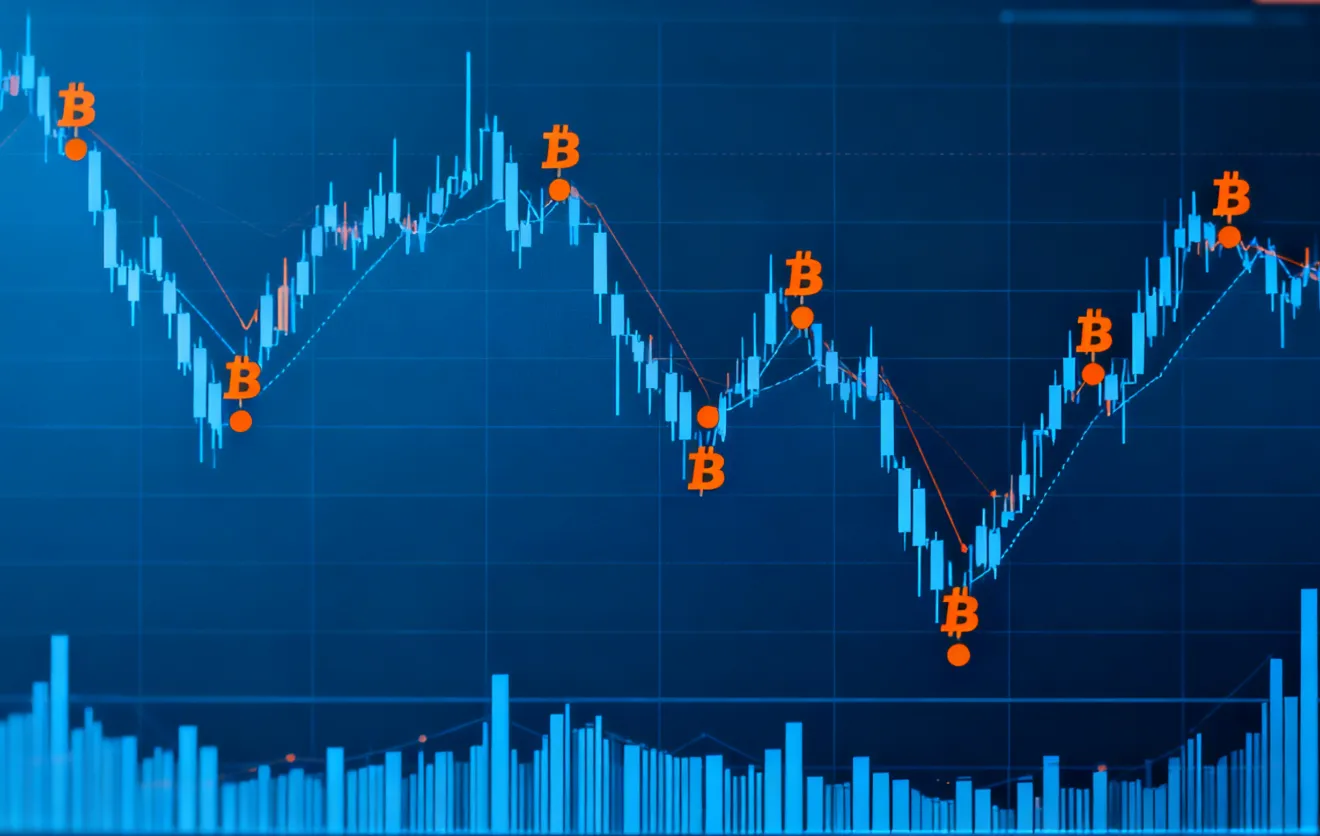After several weeks of repeated fluctuations, the cryptocurrency market finally experienced its most severe drop this week. Bitcoin was ruthlessly hammered down from its high near $100,000 by relentless bearish candles, eventually falling below $90,000 without even a decent rebound.
Ethereum was not spared either, with even deeper declines. The chill in the market rapidly spread within just 48 hours, forcing whales and institutions to accept real and painful pullbacks, while leveraged positions were liquidated in a chain reaction, and sentiment quickly shifted from cautious to panic.
Many investors have been asking these days: "What exactly happened? Why did it drop so fast? Where is the bottom?"

1. Market Fragility Under Macroeconomic Clouds
● The first wave of cold air felt by the market came from the macro level. Since November, public statements from Federal Reserve officials have shown significant divergence, as if the entire monetary policy committee is pulling in different directions. This conflicting rhetoric has made the previously warm expectation of a "slight rate cut in December" suddenly waver.
● What the market fears most about interest rate expectations is not high rates themselves, but uncertainty.
● The prolonged budget dispute has led to finger-pointing among congressional members, raising concerns that the government may again face the risk of a temporary shutdown.
● Government spending needs remain high, with no obvious signs of contraction in defense budgets, subsidy programs, or infrastructure spending, which means that Treasury bond issuance will remain under pressure in the coming months.
● The yield on U.S. long-term Treasuries has risen again, and the increase in risk-free rates continues to drain market liquidity.
For crypto assets that rely on "story + liquidity," this is akin to a heavy blow.
2. Pain for Whales and Institutions
If the macro environment was just the prologue, the real collapse of the market was due to its structural fragility.
● Over the past month, large accounts of BTC and ETH have continuously increased leveraged long positions. The long-short ratio of Bitcoin perpetual contracts once reached a new high for the phase, with many institutions choosing to chase prices near $100,000. Funds accumulated under the influence of a sprint mentality and inertia, forming a massive "leverage antenna."
The problem is that prices did not continue to reach new highs, making high-leverage positions increasingly dangerous.
● When Bitcoin fell below $95,000, a large number of stop-loss orders and forced liquidations were triggered in an instant, causing the price to break through several support levels, ultimately crashing through the $90,000 mark.
● On-chain data shows that over the past 24 hours, the total liquidation amount across the network exceeded $1 billion, with long positions accounting for the vast majority. This scene almost replicated the typical pattern of previous downturns—it was not the shorts defeating the longs, but the longs stepping on themselves.
● Some whales' unrealized profits evaporated instantly, and some large ETH positions shifted from profit to forced liquidation. Institutions originally hoped to "add positions on dips," but when the leverage chain was broken, they could only watch the risk expand and chose to protect themselves first. This type of decline under such a structure is fast, powerful, and more destructive.
3. BTC Technical Analysis: Long-term Trend Intact, Mid-term Deep Drop Nearing End
Weekly Cycle: Deeply Oversold, Approaching Technical Reversal Threshold
The most critical adjustment signal for BTC appears on the weekly chart.
Weekly characteristics:
Price breaks below the lower Bollinger band → Clearly oversold
MACD death cross expands, green bars continue to grow → Downtrend enters accelerated final stage
KDJ falls below 20 into the oversold zone → Enters "rebound window"
RSI approaches the 30–35 area → Typical cyclical downward jump area
Historical backtesting shows:
When BTC weekly KDJ < 20, a medium-level rebound has occurred in all six previous instances. The reversal is not due to oversold indicators, but rather the resonance of "golden cross + reclaiming the lower band" after being oversold.
3-Day K Cycle: Main Trend Weakens, Inertia Downward After Breaking Mid-Band
The 3-day cycle is a mid-term trend cycle between weekly and daily K, often used to capture trend reversals.
Bollinger Bands (BOLL)
The mid-band has been broken by a large bearish candle, marking the first clean break since the entire bull market.
The lower band has not yet been touched, indicating that there is still room for further downward price discovery.
Historically (e.g., September 2023, April 2024), whenever BTC 3-day K breaks below the mid-band without touching the lower band, the market tends to undergo a period of accelerated decline.
MA
MA5 and MA10 have shown a clear death cross and are diverging downward.
MA20's slope has flattened from upward, which is an important signal of trend top dulling.
If the 3-day K continues to stay below MA20, the trend will shift from "pullback" to "mid-term reversal."
MACD
DIF has accelerated downward, breaking below DEA, with energy bars continuing to deepen, and momentum has not shown signs of convergence.
Consistent with the bull market peak phases (2021, early 2024), the current MACD has entered a "one-sided downward segment," typically not showing a V-reversal but needing to build a bottom divergence near the zero axis.
Daily Cycle: Inertia Downward Nearing End, Rebound Could Trigger Anytime
The daily chart is currently in the final stage of a bearish trend. A short-term rebound could occur at any time, but its strength depends on when the weekly chart resonates.
Specific manifestations:
MACD death cross continues, but green bars show signs of "shortening attempts"
KDJ has been consolidating in the oversold zone for several days → Probability of bottom divergence increases
RSI < 35 → Typical oversold segment
Price has repeatedly formed "bottoming doji" near the lower Bollinger band, indicating that selling pressure is beginning to wane.
4. ETH Technical Analysis: Structure Weak, But Core Support Intact
Compared to BTC, Ethereum's structure resembles a combination of "mid-term washout + liquidity contraction." ETH has not destroyed its long-term upward structure; it has merely entered a "deeper mid-level correction than BTC" ahead of time.
Weekly Cycle: Clear Oversold, Key Support at 3150–3200 About to be Tested
Multiple institutions believe that ETH's technical support is around $3,150. This round of correction is deep but controllable and has not formed a trend reversal.
Weekly indicators point to limited downward space:
RSI ≈ 30, reaching typical oversold levels
MACD shows an accelerating downward pattern, but like BTC, if the green bars start to shorten, it indicates "marginal improvement in trend"
KDJ hovers below 20 → Again confirms that "the rebound window is near"
The weekly Bollinger lower band has been broken → The market has entered a short-term deep drop zone
3-Day K Cycle: Structure Weaker than BTC After Breaking Mid-Band
ETH's 3-day K shows a more pronounced breakdown structure:
Bollinger Bands
After breaking the mid-band, ETH shows an accelerating downward structure, with the lower band further opening.
From the chart, ETH's K-line runs close to the lower band, indicating that a "weak channel" has formed.
Moving Average System
MA5, MA10, and MA20 are all in a bearish arrangement.
All moving averages have downward slopes, which is a typical signal of a mid-term trend turning bearish.
MA30 still dominates pressure from above; as long as the price remains below the 30 MA, stabilization is difficult to achieve.
MACD
Similar to BTC, but the bearish bars are deeper.
DIF and DEA are completely separated, indicating that ETH has not yet shown energy signals for a rebound.
Daily Cycle: Bearish Energy Exhaustion, Reversal May Occur Before BTC
This is a very interesting point for ETH: The daily bottom divergence signal for ETH is clearer than for BTC.
RSI < 35 has been consolidating for two consecutive days
KDJ is consolidating at a low level and shows a tendency for an early golden cross
The rate of decline is slowing → A typical form of "not being able to fall further"
Multiple long lower shadows → Suggests that buying pressure is beginning to take hold.
5. When Will the Market Stabilize?
In the past, every true bottom required at least three signals to appear simultaneously. The current market still has gaps in fully meeting these three signals.
Signal One: Stabilization of Macroeconomic Expectations
● Federal Reserve policy paths realign
● Treasury yields decline
● Liquidity expectations improve again
Currently, these conditions have not been met, but market sentiment has shifted from "optimistic" back to "realistic," which is the first step toward bottoming.
Signal Two: Technical Completion of "Key Reversal"
For BTC, this means:
● Stabilizing at 90,000–92,000
● Reclaiming above 95,000
● Ultimately forming a breakout in the 98,000–100,000 range
Only then can the market return to a strong structure.
Signal Three: Clean Out of Leverage
When open interest returns to the mean range, the long leverage ratio declines, and liquidation volume decreases, only then can the market pressure be considered truly released.
6. Risks and Outlook
The most critical question right now is not "Will it drop further?" but rather "Has the market entered the final stage?"
Risks still exist, including:
● Macroeconomic policy divergence may trigger volatility again
● ETH's weak structure may drag down the overall market
● The leverage chain has not yet been completely cleaned out
On the other hand, the market is also rapidly approaching an emotional tipping point. This round of panic is not like last year's systemic explosion, but more like a deep turnover occurring at a high level. Excessive leverage is being washed out, chasing buyers are exiting, and mid-line funds are reassessing risks—all of this is actually part of a healthy market cycle.
It currently resembles "the most important deep correction in this round of the upward cycle," rather than a trend ending. The true stabilization point still hinges on whether BTC can hold 90,000–92,000 and reclaim 95,000 in this critical battle.
As long as these two conditions are met, the market will welcome upward momentum again; if not, it will need to wait for consolidation, and may even probe lower support to complete the turnover.
Join our community to discuss and grow stronger together!
Official Telegram community: https://t.me/aicoincn
AiCoin Chinese Twitter: https://x.com/AiCoinzh
OKX benefits group: https://aicoin.com/link/chat?cid=l61eM4owQ
Binance benefits group: https://aicoin.com/link/chat?cid=ynr7d1P6Z
免责声明:本文章仅代表作者个人观点,不代表本平台的立场和观点。本文章仅供信息分享,不构成对任何人的任何投资建议。用户与作者之间的任何争议,与本平台无关。如网页中刊载的文章或图片涉及侵权,请提供相关的权利证明和身份证明发送邮件到support@aicoin.com,本平台相关工作人员将会进行核查。



